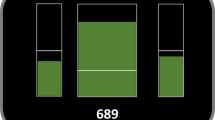Abstract
Forty-eight normal subjects from a college population, representing extreme internal and external orientations on a locus of control scale, were provided an auditory signal in a laboratory relaxation setting. For one group (feedback) the pitch of the signal varied as a function of frontal electromyographic (EMG) levels, while for another group (control) the pitch was constant. The feedback subjects acquired lower EMG potentials than did the control subjects, and the internal subjects in the feedback condition acquired lower levels than did the external subjects. In the control condition, no consistent differences in EMG levels between internal and external subjects were obtained. These results were stable across two replications, three ethnically distinct groups, and both sexes. Additional measures designed to reflect the effects of the frontal EMG training as a generalized relaxation technique for this population, including finger temperatures and a variety of postexperiment questionnaire ratings of relaxation, yielded negative results. Tests of other predictions from the locus of control construct are also discussed.
Similar content being viewed by others
References
Alexander, A. B. An experimental test of assumptions relating to the use of electromyographic biofeedback as a general relaxation training technique.Psychophysiology 1975,12 656–662.
Budzynski, T. H., & Stoyva, J. M. An instrument for producing deep muscle relaxation by means of analog information feedback.Journal of Applied Behavior Analysis 1969,2 231–237.
Budzynski, T. H., & Stoyva, J. M. Biofeedback techniques in behavior therapy. In N. Birbaumer (Ed.),Neuropsychologie der Angst. Reihe Fortschritte der Klinischen Psychologie. Bd. 3. Munchen, Berlin, Wien: Verlag Urban & Schwarzenberg, 1973.
Gatchel, R. Change over training sessions of relationship between locus of control and voluntary heart rate control.Perceptual and Motor Skills 1975,40 424–426.
Goesling, W., May, C., Lavont, D., Barnes, T., & Carreira, C. Relation between I/E locus of control and operant conditioning of alpha through biofeedback training.Perceptual and Motor Skills 1974,39 1339–1343.
Hsieh, T. T., Skyhut, J., & Lotsof, E. J. Internal versus external control and ethnic group membership: A cross-cultural comparison.Journal of Consulting and Clinical Psychology 1969,33 122–124.
Johnson, R. K., & Meyer, R. G. The locus of control construct in EEG alpha rhythm feedback.Journal of Consulting and Clinical Psychology 1974,42 913.
Lefcourt, H.Locus of control. Hillsdale, New Jersey: Lawrence Erlbaum, 1976.
Minke, K. A., & Carlson, J. G.Psychology and life unit mastery system instructor's guide. Chicago: Scott-Foresman, 1975.
Nowicki, S., & Strickland, B. A locus of control scale for children.Journal of Consulting and Clinical Psychology 1973,40 148–154.
Phares, E. J.Locus of control: A personality determinant of behavior. Morristown, New Jersey: General Learning Press, 1973.
Phares, E. J.Locus of control in personality. Morristown, New Jersey: Silver-Burdett, 1976.
Ray, W. J. The relationship of locus of control, self-report measures, and feedback to the voluntary control of heart rate.Psychophysiology 1974,11 527–534.
Rotter, J. B. Generalized expectancies for internal versus external control of reinforcement.Psychological Monographs, 1966,80 (1, Whole No. 609).
Sittenfeld, P., Budzynski, T., & Stoyva, J. Differential shaping of EEG theta rhythms.Biofeedback and Self-Regulation 1976,1 31–46.
Surwit, R. S., Shapiro, D., & Feld, J. Digital temperature autoregulation and associated cardiovascular changes.Psychophysiology 1976,13 242–248.
Wagner, C., Bourgeois, A., Levenson, H., & Denton, J. Multidimensional locus of control and voluntary control of GSR.Perceptual and Motor Skills 1974,39 1142.
Author information
Authors and Affiliations
Additional information
This research was supported by NIMH Special Postdoctoral Fellowship No. MH58202-01.
Rights and permissions
About this article
Cite this article
Carlson, J.G. Locus of control and frontal electromyographic response training. Biofeedback and Self-Regulation 2, 259–271 (1977). https://doi.org/10.1007/BF00998651
Received:
Issue Date:
DOI: https://doi.org/10.1007/BF00998651




